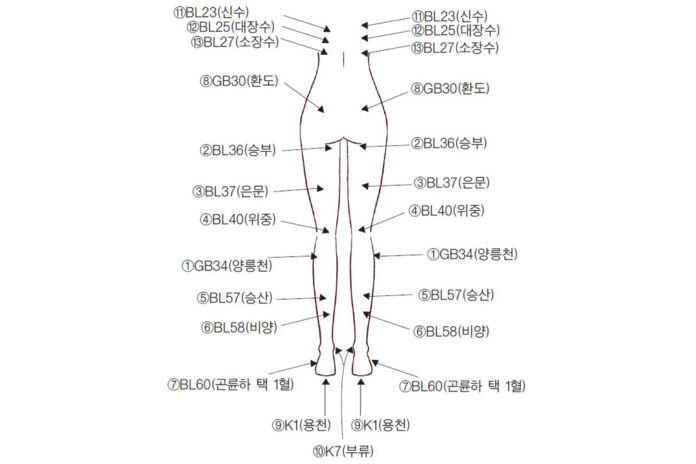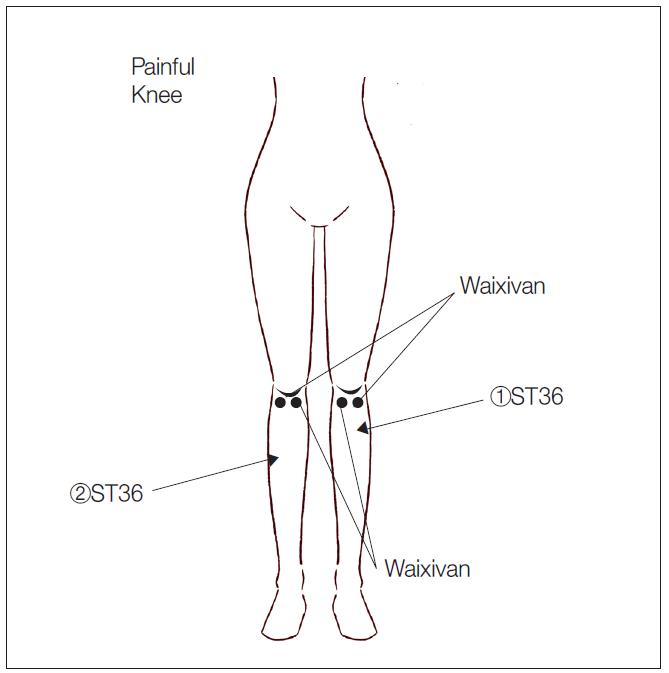
Underlying Theories of Acupuncture Treatment (35) Chugoongtongrak Technique for the knee joint treatment
By Brandon SJ Oh, L.Ac.
This month, I will explain knee pain treatment and severe paraplegia using Chugoongtongrak Technique.
Ⅰ. Chugoongtongrak Technique (推窮通絡取穴法) for Treatment of Paraplegia
Principles for Applying Chugoongtongrak Technique
Use only tonifying each acupuncture point as needle insertion. The technique is designed to stimuli multiple points on the Urinary Bladder to enhance the meridian’s normal function for severe paraplegia patients.
Chugoongtongrak Technique is also created to treat overall leg symptoms. Therefore, restoring the balance of Qi movements of the leg could be achieved by using either GB34 or GB39. GB34 and GB39 are known as ‘eight meeting points.’ GB34 is where the tendon meets, and GB39 is where the marrow meets, respectively. Picking up one acupuncture point among GB34 and GB39 is dependent on diagnosis of the symptom and has to be determined either tendon or marrow should be treated to regain normal function of the legs.
GB30 is used to strengthen descending Qi down through Yang meridians located on the legs, and K1 propels Qi upward through leg meridians. GB30 and K1 can accomplish stronger Qi movement through the legs meridians to overcome paralysis symptoms.
The technique should be strictly obeyed the needle insertion arrangement, such as taking one acupuncture point located on leg Taiyang meridian first, then moving to GB30 and K1. Otherwise, activated Qi movement by inserting needles will cause compromised Qi movement on the legs.
Apply Chugoongtongrak Technique and meanings of each acupuncture point using
- The axis points should be either GB34 or GB39 on both sides to balance the Qi movement.
- BL36 will act as switchgear of Qi movement on the Urinary Bladder meridian.
- BL37 is used because the points are located on the thighs.
- BL40 is for harmonizing Qi movement on the meridian.
- BL57 and BL58 are located on the calf.
- Choose one acupuncture point located below the BL60, which acts as compulsive points of the Urinary Bladder meridian.
- K1 is related to the Urinary Bladder as exterior and interior relation and can push Qi movement from the feet to the head.
- K7 is used to help the function of K1.
- After completing insertion on the legs, take GB30. All needles should have stayed.
- All needles should be on their location for 10 to 15 minutes.
- The Heaven Taiji points are not used.
- If a patient is not too weak, you can add e-stim acupuncture points such as GB30, BL36, BL37, or UB40, BL57, BL58 in groups to increase the treatment effect.
Ⅱ. Chugoongtongrak Technique (推窮通絡取穴法) For the Knee Pain

The knee joints are where most body weight is loaded and have more range of motion than ankles. Therefore, the knee joint connected and controlled by the cruciate ligament could be easily damaged, especially one exposed to excessive exercise or aged groups.
Treatment for knee pain patients without knee cartilage requires a lot longer time to treat and manage pain. Early-stage of the knee pain started on one side but due to compensation, later the other side also damaged and be painful at the end. If the knee pain prolonged without treatment, usually the patient’ knee cartilages will be damaged and worn out.
Many academic studies confirm that acupuncture treatment for a knee pain patient without cartilage damage reduces pain, and even degenerated cartilage was regenerated.
Psychroalgia is usually found if a person exposure to cold as he/she loses track during hiking or sleeps in cold places in winter. In the cases, coldness directly attacks the knees and result in knee pain with psychroalgia. One more possibility is that a person has been feeling constant coldness in the body through his/her lifetime and aging can make with or without knee pain with psychroalgia. Knee pain with psychroalgia is also treated with acupuncture treatment.
Treatment
Asymmetrical knee pain cases
Stimulating two ST36, as I explained, helps regain balance on the right and left sides of the body. Use ST36 as an axis point which is located on the other side of pain, then stimuli ST36 on the pain side. Next, to enhance the function of the axis point located on the other side of the pain area, add SP5, which is interor-exterior relationship with the Stomach meridian, to modify Qi movement. Finally, add needles on ST35, the point on the other side of ST35, and the top of the patella. As you insert needles on the knee, it is important to maintain that the insertion angle should be less than 45 degrees. Otherwise, it increases the chance of destroying a bursa.
Symmetrical Knee pain cases
Right and left ST36 → One each needle on ST35, the point on the other side of ST35, and the top of the patella
Psychroalgia
There are two possible treatments for the symptom. One is applying Fire Needle Therapy, which uses an acupuncture needle and moxa to transport heat to the pain area, and the other is mixing Eight Extraordinary Meridians. To use Eight Extraordinary Meridians is using two sequences as follows:
HT3 → SI3 → BL62 → K10 → CV4 → CV3 and GB41 → Lv8 → PC3 → TE5 → CV5
Then, use knee pain treatment methods as I introduced earlier.
































